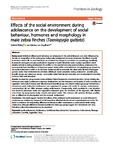Effects of the social environment during adolescence on the development of social behaviour, hormones and morphology in male zebra finches (Taeniopygia guttata)
| dc.contributor.author | Bölting, S | |
| dc.contributor.author | von Engelhardt, N | |
| dc.date.accessioned | 2017-02-08T10:02:32Z | |
| dc.date.accessioned | 2017-02-08T10:09:33Z | |
| dc.date.available | 2017-02-08T10:02:32Z | |
| dc.date.available | 2017-02-08T10:09:33Z | |
| dc.date.issued | 2017-01-25 | |
| dc.identifier.issn | 1742-9994 | |
| dc.identifier.issn | 1742-9994 | |
| dc.identifier.other | 5 | |
| dc.identifier.uri | http://hdl.handle.net/10026.1/8427 | |
| dc.description.abstract |
BACKGROUND: Individual differences in behaviour are widespread in the animal kingdom and often influenced by the size or composition of the social group during early development. In many vertebrates the effects of social interactions early in life on adult behaviour are mediated by changes in maturation and physiology. Specifically, increases in androgens and glucocorticoids in response to social stimulation seem to play a prominent role in shaping behaviour during development. In addition to the prenatal and early postnatal phase, adolescence has more recently been identified as an important period during which adult behaviour and physiology are shaped by the social environment, which so far has been studied mostly in mammals. We raised zebra finches (Taeniopygia guttata) under three environmental conditions differing in social complexity during adolescence - juvenile pairs, juvenile groups, and mixed-age groups - and studied males' behavioural, endocrine, and morphological maturation, and later their adult behaviour. RESULTS: As expected, group-housed males exhibited higher frequencies of social interactions. Group housing also enhanced song during adolescence, plumage development, and the frequency and intensity of adult courtship and aggression. Some traits, however, were affected more in juvenile groups and others in mixed-age groups. Furthermore, a testosterone peak during late adolescence was suppressed in groups with adults. In contrast, corticosterone concentrations did not differ between rearing environments. Unexpectedly, adult courtship in a test situation was lowest in pair-reared males and aggression depended upon the treatment of the opponent with highest rates shown by group-reared males towards pair-reared males. This contrasts with previous findings, possibly due to differences in photoperiod and the acoustic environment. CONCLUSION: Our results support the idea that effects of the adolescent social environment on adult behaviour in vertebrates are mediated by changes in social interactions affecting behavioural and morphological maturation. We found no evidence that long-lasting differences in behaviour reflect testosterone or corticosterone levels during adolescence, although differences between juvenile and mixed-age groups suggest that testosterone and song behaviour during late adolescence may be associated. | |
| dc.format.extent | 5- | |
| dc.format.medium | Electronic-eCollection | |
| dc.language | en | |
| dc.language.iso | en | |
| dc.publisher | Springer Science and Business Media LLC | |
| dc.relation.replaces | http://hdl.handle.net/10026.1/8426 | |
| dc.relation.replaces | 10026.1/8426 | |
| dc.subject | Social environment | |
| dc.subject | Adolescence | |
| dc.subject | Social interactions | |
| dc.subject | Maturation | |
| dc.subject | Testosterone | |
| dc.subject | Corticosterone | |
| dc.subject | Plumage colouration | |
| dc.subject | Courtship | |
| dc.subject | Aggression | |
| dc.subject | Song | |
| dc.title | Effects of the social environment during adolescence on the development of social behaviour, hormones and morphology in male zebra finches (Taeniopygia guttata) | |
| dc.type | journal-article | |
| dc.type | Journal Article | |
| plymouth.author-url | https://www.webofscience.com/api/gateway?GWVersion=2&SrcApp=PARTNER_APP&SrcAuth=LinksAMR&KeyUT=WOS:000392672900001&DestLinkType=FullRecord&DestApp=ALL_WOS&UsrCustomerID=11bb513d99f797142bcfeffcc58ea008 | |
| plymouth.issue | 1 | |
| plymouth.volume | 14 | |
| plymouth.publication-status | Published online | |
| plymouth.journal | Frontiers in Zoology | |
| dc.identifier.doi | 10.1186/s12983-017-0190-4 | |
| plymouth.organisational-group | /Plymouth | |
| plymouth.organisational-group | /Plymouth/Faculty of Science and Engineering | |
| plymouth.organisational-group | /Plymouth/Faculty of Science and Engineering/School of Biological and Marine Sciences | |
| plymouth.organisational-group | /Plymouth/REF 2021 Researchers by UoA | |
| plymouth.organisational-group | /Plymouth/REF 2021 Researchers by UoA/UoA04 Psychology, Psychiatry and Neuroscience | |
| plymouth.organisational-group | /Plymouth/Users by role | |
| plymouth.organisational-group | /Plymouth/Users by role/Academics | |
| dc.publisher.place | England | |
| dcterms.dateAccepted | 2017-01-18 | |
| dc.identifier.eissn | 1742-9994 | |
| dc.rights.embargoperiod | No embargo | |
| rioxxterms.versionofrecord | 10.1186/s12983-017-0190-4 | |
| rioxxterms.licenseref.uri | http://www.rioxx.net/licenses/all-rights-reserved | |
| rioxxterms.licenseref.startdate | 2017-01-25 | |
| rioxxterms.type | Journal Article/Review | |
| plymouth.oa-location | http://frontiersinzoology.biomedcentral.com/articles/10.1186/s12983-017-0190-4 |


